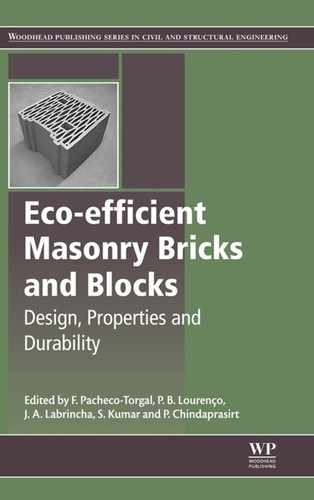The properties and durability of mine tailings-based geopolymeric masonry blocks
Abstract
The growing concerns about global warming and diminishing natural resources have led to research on developing innovative methods for producing green and sustainable construction materials. Utilization of mine tailings (MT) to produce geopolymer masonry blocks is a novel way to meet the emerging needs. The major challenge with the utilization of MT as construction material is their reactivity and phase composition, which can be addressed by improving geopolymerization through different methods such as preactivation by heating, addition of highly reactive materials, utilization of appropriate activator and curing temperature, and addition of calcium to the mixture. This chapter describes the physical and mechanical properties of MT-based geopolymer masonry blocks. The durability of MT-based geopolymer in aggressive environments and the effectiveness of immobilization of contaminants in the original MT after geopolymerization are also discussed.
Keywords
Durability; Geopolymer; Heavy metals; Masonry blocks; Mechanical properties; Microstructure; Mine tailings13.1. Introduction
13.2. Mine tailings (MT)-based geopolymer
![]() (13.1)
(13.1)

Table 13.1
Summary of information on different types of MT used by different researchers for geopolymer synthesis
| Source of MT | Initial Si/Al | Product application | Curing temperature (°C) | Improvement method | References |
| Copper mine | 7.8 | Undefined | 60 | Addition of fly ash | Zhang et al. (2011) |
| Copper mine | 7.8 | Masonry block | 90 | Elevated curing temperature/precompression | Ahmari and Zhang (2012) |
| Tungsten mine | 2.73 | Undefined | Room | Dehydroxylation | Pacheco-Torgal et al. (2008a, 2010) |
| Copper and gold mine | 2.69–14.4 | Mining backfill | 70 | Addition of fly ash or slag | Southam et al. (2007) |
| Red mud | 0.3 | Building materials | 60 | Addition of ferronickel slag | Giannopoulou et al. (2009) |
| Gold mine | 3.5–4.5 | Capping of hypersaline MT | Room | Addition of fly ash | Van Jaarsveld et al. (2000) |
| Copper mine | 6.7 | Stabilization of tailings | 60 | Addition of fly ash | Giannopoulou and Panias (2006) |

13.2.1. Dehydroxylation of MT
 (13.2)
(13.2)
13.2.2. Addition of other aluminosilicate source material
13.2.3. Utilization of soluble silica in activation solution
13.2.4. Use of appropriate curing temperature
Table 13.2
Optimum curing temperatures from different researchers for different source materials
| Source material | Optimum curing temperature (°C) | NaOH concentration (M) | References |
| Natural zeolite | 40 | 7 | Villa, Pecina, Torres, and Gómez (2010) |
| Glass cullet | 40 | 5–10 | Cyr, Idir, and Poinot (2012) |
| Class C fly ash | 60 | 8.1 | Guo, Shi, and Dick (2010) |
| Class F fly ash | 75 | 7.5 | Van Deventer et al. (2006) |
| Class C fly ash | 75 | 8.1 | Guo et al. (2010) |
| Class F fly ash | 80 | 7 | Yunfen, Dongmin, Wenjuan, Hongbo, and Lin (2009) |
| Metakaolin | 85 | 13.6 | Yao, Zhang, Zhua, and Chen (2009) |
| MT | 75 | 5 and 10 | Ahmari et al. (2012a) |
| MT | 90 | 15 | Ahmari et al. (2012a) |

13.2.5. Addition of calcium
13.3. Synthesis and physical and mechanical properties of MT-based geopolymer masonry blocks
13.3.1. Synthesis of MT-based geopolymer masonry blocks

13.3.2. Physical and mechanical properties of MT-based geopolymer masonry blocks


Table 13.4
Physical and mechanical properties of MT-based geopolymer blocks prepared at 16% initial content and cured at 90 °C for seven days
| Forming pressure (MPa) | UCS (MPa)/(psi) | Unit weight (kN/m3) | 24 h water absorption (%) | Abrasion index |
| 0.5 | 28/4040 | 19.66 | 0.93 | 0.02 |
| 1.5 | 25/3591 | 19.70 | 2.18 | 0.06 |
| 3.0 | 22/3250 | 19.89 | 2.92 | 0.09 |
| 5.0 | 21/3086 | 19.93 | 3.45 | 0.11 |
| 15.0 | 21/3059 | 19.96 | 3.15 | 0.10 |

 (13.3)
(13.3)
Table 13.5
ASTM specifications for different applications of bricks and blocks
| Title of specification | ASTM designation | Type/grade | Minimum UCS (MPa) | Maximum water absorption (%) | Abrasion index | |
| Structural clay load bearing wall tile | C34-03 | LBX | 9.6 | 16 | NA | |
| LBX | 4.8 | 16 | NA | |||
| LB | 6.8 | 25 | NA | |||
| LB | 4.8 | 25 | NA | |||
| Building brick | C62-10 | SW | 20.7 | 17 | NA | |
| MW | 17.2 | 22 | NA | |||
| NW | 10.3 | No limit | NA | |||
| Solid masonry unit | C126-99 | Vertical coring | 20.7 | NA | NA | |
| Horizontal coring | 13.8 | NA | NA | |||
| Facing brick | C216-07a | SW | 20.7 | 17 | NA | |
| MW | 17.2 | 22 | NA | |||
| Pedestrian and light traffic paving brick | C902-07 | SX | 55.2 | 8 | Type I | 0.11 |
| MX | 20.7 | 14 | Type II | 0.25 | ||
| NX | 20.7 | No limit | Type III | 0.50 | ||

Notes: LBX = load bearing exposed; LB = load bearing nonexposed; SW = severe weathering; MW = moderate weathering; NW = negligible weathering; SX = severe exposure; MX = moderate exposure; NX = negligible exposure; and Type I, II, and III = subjected to extensive, intermediate, and low abrasion, respectively.





